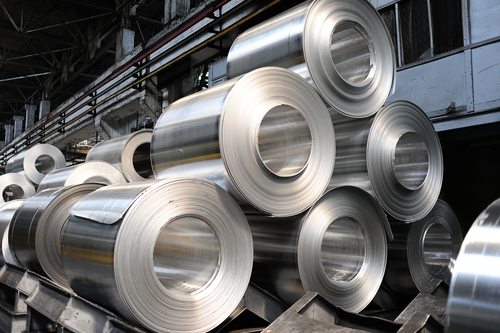
By Anushka Verma
India’s aluminum industry stands at a crossroads. By strategically leveraging the benefits of secondary aluminum while simultaneously prioritizing the growth of our domestic primary aluminum industry, we can unlock a future brimming with potential.
On its journey to becoming a $10 trillion economy, India is heavily reliant on a robust manufacturing sector. Aluminum, a lightweight and versatile metal, finds itself at the center of this narrative.
It’s used in everything from automobiles to airplanes to kitchen utensils. A critical issue plagues this crucial sector – the import of low-cost aluminum scrap, primarily from US and the Gulf countries.
Aluminum comes in two main forms – primary and secondary. Primary aluminum is produced from the ore, which is called bauxite. Secondary aluminum is produced from aluminum scrap that comes from old soda cans, car parts, old airplanes, and is heavily mixed with other substances which are often toxic, such as lead and arsenic.
While secondary aluminum offers a seemingly attractive cost advantage over primary aluminum, this comes at a potentially crippling cost to our domestic industry and long-term supply chain security.
India’s import duty on aluminum scrap stands at a mere 2.5%, significantly lower than the 7.5% levied on primary aluminum. This disparity incentivizes the import of scrap over domestically mined aluminum ores for production of aluminum.
Due to such tariff disparity, and the fact that aluminum scrap is by definition, a low quality source of aluminum due to massive amounts of toxic impurities, secondary aluminum, especially ADC-12 alloy, offers a cost advantage of 15-20% compared to primary aluminum. This price undercutting has undeniably benefited downstream industries like utensils, automobiles and packaging, but at what cost?
The primary aluminum industry has been under immense pressure due to the influx of cheap aluminum scrap. The lower import duty on scrap compared to primary aluminum creates a situation of significant price undercutting.
This means recycled aluminum can be sold at a much lower price, disrupting the level playing field for domestic producers. Companies struggle to compete with the cheaper alternatives, jeopardizing their ability to modernize and improve efficiency. This not only weakens domestic manufacturing capabilities but also raises national security concerns, considering aluminum’s strategic applications in defence equipment and aerospace.
This is precisely the reason why China has imposed severe import restrictions on importing aluminum scrap, in order to safeguard their domestic industry and to ensure supply-chain resilience of their own aluminum based industries, that includes everything from cars to aerospace.
Beyond Price: The Quality Conundrum
The current system lacks stringent regulations on the quality of imported scrap raising concerns about its safety and environmental impact.
Unregulated scrap, potentially containing harmful impurities like lead or radioactive elements, can pose health risks, especially when used in applications such as utensils or electrical appliances. The unregulated recycling industry within India further adds to these concerns.
Building a Sustainable Aluminum Ecosystem: A Delicate Balancing Act
India’s vision of Atmanirbhar Bharat necessitates a robust domestic aluminum industry. However, a knee-jerk reaction like a complete ban on aluminum scrap imports wouldn’t be a sustainable solution.
While India does generate aluminum scrap domestically, this amount currently falls short of meeting the country’s rapidly growing demand for aluminum. This necessitates a balanced approach that leverages the benefits of both primary and secondary aluminum production.
The key lies in establishing a sustainable aluminum ecosystem that encourages increased domestic scrap generation alongside strategic use of imports to bridge the gap. To achieve this, a multi-pronged strategy is essential.
First, calibrated import duties on aluminum scrap can create a level playing field for domestic producers, while also acting as an incentive for increased domestic recycling efforts. In fact, we need to leverage trade remedy tools such as Safeguards with Quantitative Restrictions (QR) on aluminum scrap and imposing anti-dumping duties (ADD) on aluminum scrap on an urgent basis.
Second, India needs to prioritize strengthening domestic scrap collection and processing infrastructure. This will not only reduce import dependence but also promote a circular economy.
However, a crucial element in this strategy is ensuring the quality of aluminum scrap entering the ecosystem. Implementing stringent quality checks based on international standards like ISRI is essential.
Finally, investing in research and development (R&D) for cleaner and more efficient production methods across both primary and secondary aluminum production is crucial for long-term economic and environmental sustainability.
A Call for Collective Action
India’s aluminum industry stands at a crossroads. By strategically leveraging the benefits of secondary aluminum while simultaneously prioritizing the growth of our domestic primary aluminum industry, we can unlock a future brimming with potential.
This approach will not only create a robust and self-reliant aluminum ecosystem but also ensure long-term supply chain resilience. A thriving domestic aluminum industry will empower India’s manufacturing prowess, propelling us onto the world stage as a global leader.
In the short-term, we need to urgently curtail the unchecked flow of aluminum scrap into India, which has been exacerbated with China’s ban on import of aluminum scrap.
This article first appeared in ET Government,